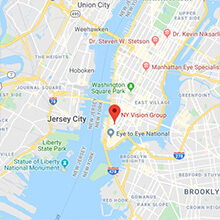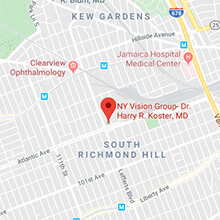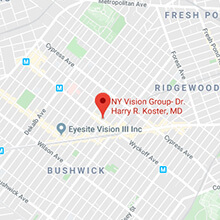A sad scene in a movie or the funeral of a loved one can make your tears flow. But tears aren’t produced only on sad occasions. Healthy eyes are continuously covered by a tear film — a continuous layer of fluid —which prevents dry eyes and allows your eyes to maintain clear, comfortable vision. The tear film protects your eyes and lubricates them. It also reduces the risk of eye infection and, with each blink, helps clear your eyes of any debris. When your eyes become irritated by dust, smoke or fumes, extra tears help wash away the foreign material.
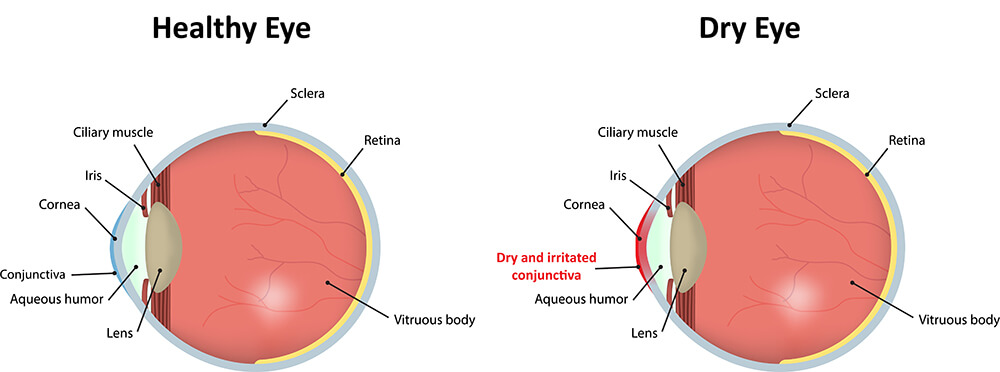
Dry eyes are a common source of discomfort, particularly as we age, and can become a chronic problem. A variety of treatment options exist for dry eyes and NY Vision Group tailors each treatment plan to each individual patient’s needs.
Symptoms
Symptoms of dry eyes may include:
- Stinging, burning or scratchy eyes
- A sense of a foreign substance in your eyes
- Increased eye irritation from smoke or wind
- Eye fatigue after short periods of reading
- Difficulty wearing contact lenses
- Blurred vision, often worsening at the end of the day or after intense visual concentration
- Both eyes usually are affected.
Causes
Tears are a complex mixture of water, oils, proteins, electrolytes, bacteria-fighting substances and growth factors that regulate various cell processes. This mixture helps make the surface of your eyes smooth and clear. Without tears, good vision is impossible.
For some people, dry eyes are caused by an imbalance in the composition of their tears. Other people don’t produce enough tears to keep their eyes comfortably lubricated. Eyelid problems, medications and other causes, such as environmental factors, also can lead to dry eyes.
Decreased Tear Production
Tear production tends to diminish as you get older –adults age 40 and older are more likely to experience dry eyes. If you are unable to produce enough tears, your eyes become dry and easily irritated. Although dry eyes can affect both men and women at any age, the condition more commonly affects women, especially after menopause. This may be due in part to hormonal changes. Damage to the tear glands from inflammation or radiation can hamper tear production. Dry eyes are also associated with medical conditions such as diabetes, rheumatoid arthritis, lupus, scleroderma, and Sjogren’s syndrome.
Refractive eye surgeries such as LASIK also may cause decreased tear production and dry eyes. Symptoms of dry eyes related to these procedures usually resolve after several months, particularly if patients diligently use tears as directed.
Poor Tear Quality
The tear film has three basic layers: oil, water, and mucus. Problems with any of these layers can cause dry eye symptoms.
Oil. When the oil portion of the tears is abnormal, the watery layer evaporates too quickly. Dry eye problems are more common in people whose oil is clogged or who have inflammation along the edge of their eyelids (blepharitis), rosacea and other skin disorders.
Water. The middle portion of tears, which makes up about 90 percent of tears, is mostly water with a little bit of salt. This layer cleanses your eyes and washes away foreign particles or irritants. If your eye produces only small, inadequate amounts of water, the oil, and mucus layers can touch and cause the stringy discharge familiar to people with dry eyes.
Mucus. The inner layer of mucus allows tears to spread evenly over the surface of your eyes. Dry spots form easily in any part of the cornea that has a patchy loss of the mucus layer.
Poor Lid Function
Through normal blinking, your eyelids spread a continuous thin film of tears across the surface of your eyes. As you age, problems with your eyelids can impair the complex blinking motion required to spread these tears, resulting in dry eyes. These problems include an out-turning of the lids (ectropion) or an in-turning of the lids (entropion). Blepharitis, inflammation along the edge of the eyelids, also may cause your eyes to feel dry and scratchy.
Medications
Common medications, both prescription and over-the-counter, that can cause dry eyes include:
- Diuretics, drugs commonly used to treat high blood pressure
- Antihistamines and decongestants
- Sleeping pills
- Birth control pills
- Antidepressant medications
- Isotretinoin-type drugs (Retin A) for treatment of acne
- Opiate-based pain relievers such as morphine
Other Causes of Dry Eyes
Dry eyes can be worsened by exposure to many environmental conditions, such as sun, wind, high altitude, a dry climate, hot blowing air and the dry air that commonly occurs in commercial airplanes. In addition, tasks that require intense visual concentration — such as working at a computer, driving or reading — tend to decrease your blink rate, thereby increasing tear evaporation. Finally, for some people, the cause of dry eyes is an allergic reaction to eye drops or ointments.
Treatment Options
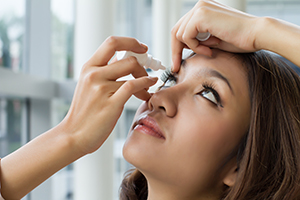 Although dry eyes don’t usually cause permanent damage, you should come see us if you’ve had prolonged symptoms of dry eyes, including red, irritated, tired or painful eyes. We can test both the quantity and the quality of your tears with a few simple tests, including the Schirmer test, in which blotting strips of paper are placed under your lower eyelids. After five minutes your doctor measures the amount of strip soaked by your tears.
Although dry eyes don’t usually cause permanent damage, you should come see us if you’ve had prolonged symptoms of dry eyes, including red, irritated, tired or painful eyes. We can test both the quantity and the quality of your tears with a few simple tests, including the Schirmer test, in which blotting strips of paper are placed under your lower eyelids. After five minutes your doctor measures the amount of strip soaked by your tears.
After careful examination of the factors which may be causing your symptoms, we may recommend the following treatment options:
Managing lid problems. If you have an eyelid condition, such as an anatomic abnormality or an incomplete blink that aggravates your dry eyes, we may recommend eyelid surgery. If your eyelids are inflamed due to blepharitis, we may recommend regular cleaning of the area with a dilute solution of baby shampoo and/or short-term, nightly treatment with antibiotic drops or ointment or treatment with an oral antibiotic such as tetracycline or doxycycline.
Adding tears. A mild case of dry eyes can usually be treated with over-the-counter artificial tears. We can suggest which drops might be best for you. You can use the lubricating drops as often as you need, even several times an hour, to provide relief. If you use drops frequently, preservative-free drops might be the best choice to avoid an allergic reaction to preservatives. You can also use ointments to ensure lubrication. These ointments can blur vision, so it’s best to use them only at bedtime.
Conserving tears. To keep your natural tears around longer we may also recommend partially or completely closing your tear ducts, which normally serve to drain tears away. The tear ducts can be plugged with tiny silicone plugs. The closure conserves both your own tears and artificial tears you may have added.
People with mild dry eyes respond well to treatment with artificial tears. Some people have persistent symptoms and don’t respond to artificial tears alone even though their eyes appear fairly normal. Severe dry eyes require more aggressive treatment, such as the silicone plugs. People with severe dry eyes also may benefit from a special customized contact lens (Boston Scleral Lens). This lens rests on the white part of the eye (sclera), creating a fluid-filled layer over the cornea that keeps it from drying out.
It’s possible that more than one variable may be contributing to your dry eye symptoms. We will work with you to devise a plan to address the factors that appear to be contributing to the problem. This process often takes time and requires patience and a trusting relationship with us.
Self Care
Like any liquid, tears will evaporate when exposed to air.
You can take these simple steps to help slow evaporation:
- Wear glasses on windy days and goggles while swimming. The wraparound style of glasses may help reduce the effects of the wind.
- Avoid air blowing in your eyes. Don’t direct hair dryers, car heaters, air conditioners or fans toward your eyes.
- Keep your home humidity between 30 percent and 50 percent. In winter, a humidifier can add moisture to dry indoor air. Avoid rubbing your eyes. You can irritate your eyes further by rubbing them.
- Take preventive steps. Use eye drops before, rather than after, your eyes become irritated as a result of visually demanding activities. Try to avoid activities that might worsen the problem.
- Remember to blink. Consciously blinking repeatedly helps spread your own tears more evenly. When performing tasks that require intense visual concentration, take occasional breaks and rest your eyes by closing your lids for several seconds. Follow this by consciously increasing your blink rate. Be especially careful to follow these suggestions if you have had LASIK or a similar procedure.

